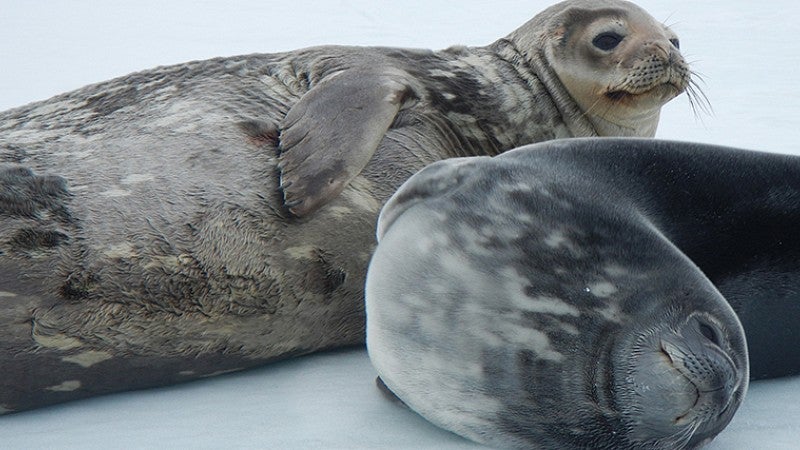Soon after a team led by University of Oregon biologist Paul Cziko installed the McMurdo Oceanographic Observatory in 2017, the mesmerizing calls of Weddell seals roaming under Antarctica’s sea ice often lulled scientists to sleep.
Two years of recordings since then, though, have led to a startling discovery. The seals, the world’s southernmost-ranging mammal, regularly produce chirps, whistles and trills at frequencies that are inaudible to humans.
“The Weddell seals’ calls create an almost unbelievable, otherworldly soundscape under the ice,” said Cziko, a visiting research professor in the UO’s Institute of Ecology and Evolution, about the seals’ usual vocalizations. “It really sounds like you’re in the middle of a space battle in ‘Star Wars,’ laser beams and all.”
The seals’ human-audible sounds, along with video from the live-streaming observatory in McMurdo Sound, were broadcast to and recorded at the nearby McMurdo Station. Personnel stationed there were able to stream the audio and video into their dorm rooms at night.
Over time, the researchers realized that their ultrasensitive broadband digital hydrophone was also recording previously undetected calls composed of high-pitched sounds.
“We kept coming across these ultrasonic call types in the data,” said marine biologist Lisa Munger, a career instructor in the UO’s Clark Honors College who studies marine mammal acoustics. “Finally, it dawned on us that the seals were actually using them quite regularly.”
Cziko, who has visited Antarctica eight times and logged 200 dives under the ice since 2002, and Munger, with 40 such dives, are lead authors on a paper detailing the discovery. It published online Dec. 18 in the Journal of the Acoustical Society of America.
The team describes nine types of tonal ultrasonic seal vocalizations that reach to 50 kilohertz. Humans hearing falls in the sonic range of 20 to 20,000 hertz, or 20 kilohertz.
“Weddell seals really are amazing animals,” Cziko said. “They inhabit some of the most inhospitable, cold and icy areas of the planet. And yet they always seem to be totally at ease, both on and under the sea ice.”
The seals thrive there, using their teeth to create air holes in the ice and diving to 600 meters in search of prey while staying submerged for up to 80 minutes. Back in 1982, researchers had described 34 seal call types, all within the range of human hearing, and attributed them to social interactions.
The nine new ultrasonic call types featured single or multiple vocal elements. Eleven of the elements, including chirps, whistles and trills, exceeded 20 kHz. Two were over 30 kHz and six were constantly above 21 kHz. One whistle reached 44.2 kHz and descending chirps in another call type began at about 49.8 kHz. The overtones of some calls exceeded 200 kHz.
“It was really surprising that other researchers previously had, in effect, missed a part of the conversation,” said Cziko, who earned a doctorate in evolutionary biology from the UO in 2014.
How Weddell seals use their ultrasonic calls is unknown. They are among 33 species of fin-footed mammals grouped as pinnipeds. Until now, pinnipeds, which also include sea lions and walruses, were believed to vocalize only at sonic levels.

It could be, Cziko said, that the seals produce the sounds simply to “stand out over all the lower-frequency noise, like changing to a different channel for communicating.”
Or, the researchers noted, the ultrasonic calls may be used for echolocation, a biological sonar that toothed whales, including dolphins, and bats use to navigate in limited visibility to avoid obstacles and locate friends or prey. Just how Weddell seals navigate and find food during the months of near absolute darkness in the Antarctic winter is a mystery.
“The possibility of seals using some kind of echolocation has really been discounted over the years,” Cziko said. “We actually had a lot of somewhat heated discussions in our group about whether or how the seals use these ultrasonic sounds for echolocation-like behaviors.”
The newly identified ultrasonic calls make up 17 percent of the seals’ known call repertoire and, the researchers noted, there is evidence that the seals can hear the ultrasonic calls.
“We’d like to know who is producing the ultrasonic calls -- males, females, juveniles, or all of the above,” Munger said. “And how are the seals using these sounds when they’re out in deeper water, looking for fish? We need to record in more places to be able to correlate sounds with behaviors.”
Nick Santos of the University of California, Merced, and John Terhune, a professor emeritus at the University of New Brunswick in Saint John, Canada, were co-authors of the study.
The National Science Foundation primarily supported the research through a grant to Cziko and Arthur L. DeVries, a professor emeritus at the University of Illinois at Urbana-Champaign who has done research in Antarctica since 1961.
“You never know what you’re going to find when you’ve got eyes and ears in the ocean, especially in Antarctica,” said Cziko, who began his work in Antarctica as an undergraduate student with DeVries.
—By Jim Barlow, University Communications

